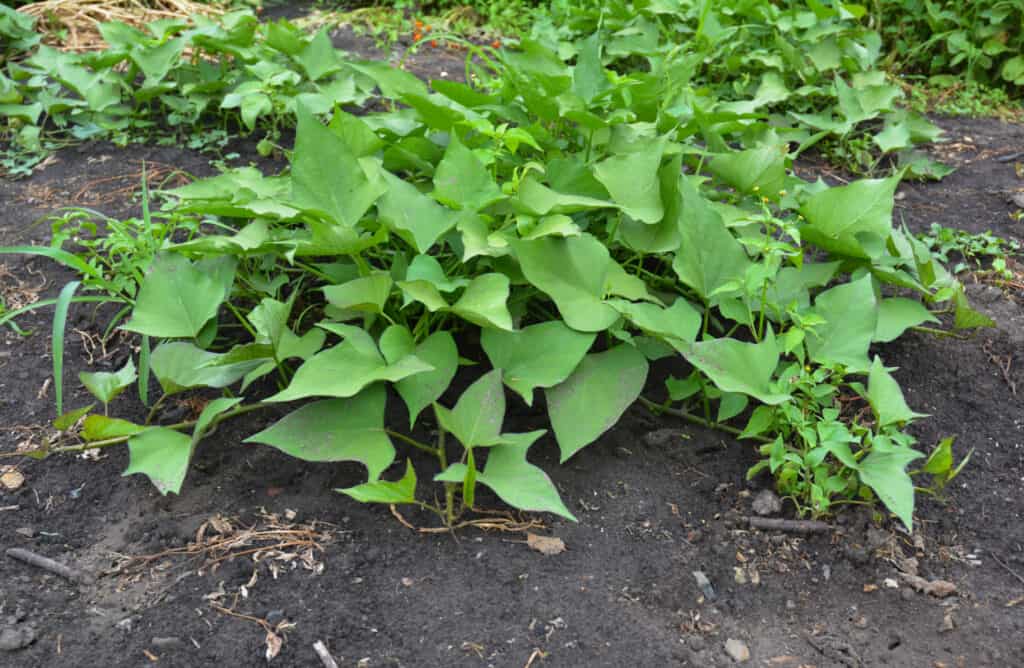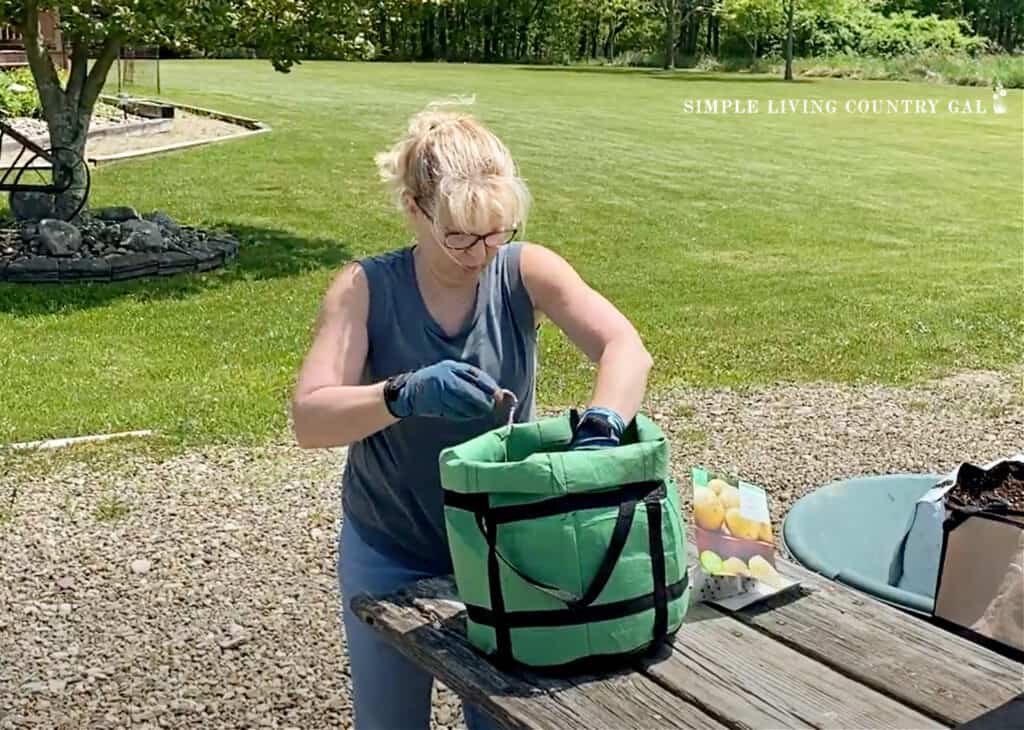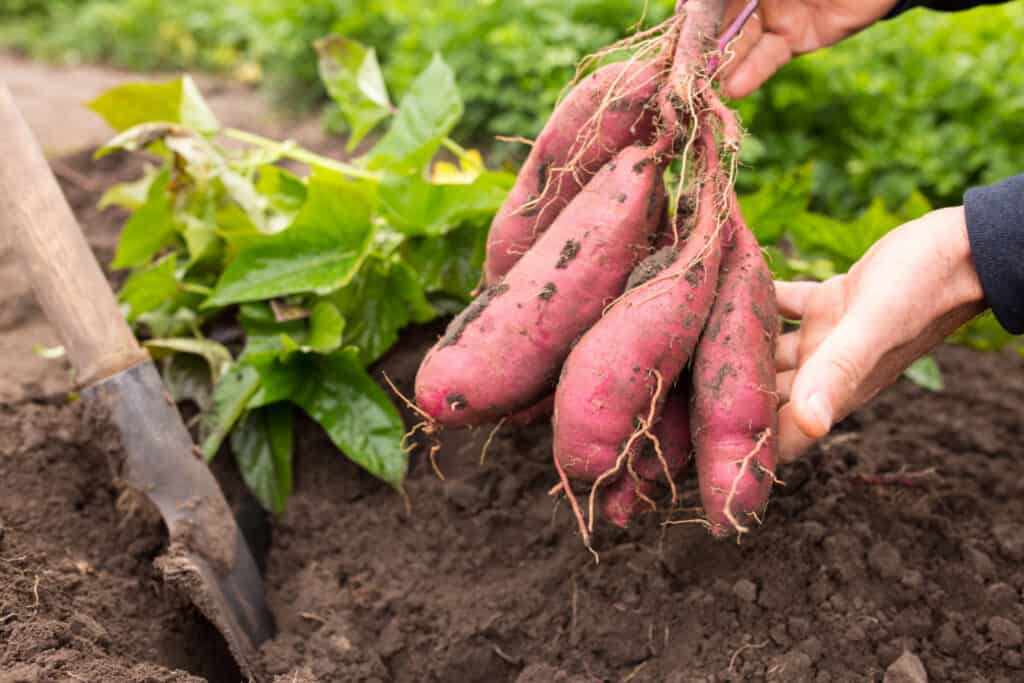How to Grow Sweet Potatoes for Beginners
If you are new to gardening, knowing how to plant and grow all the things can be a bit overwhelming. This article will help you with all the steps you need How to Grow Sweet Potatoes for Beginners.
Another great guide to add to your Gardening 101 library.

If you’re looking for a delicious and nutritious root vegetable to grow in your garden, sweet potatoes are a great option. Sweet potatoes are relatively easy to grow and provide many health benefits. In this guide, we’ll show you how to grow sweet potatoes for beginners.
Sweet potatoes can be a delicious and healthy addition to your garden. Just a few plants can produce a generous harvest, allowing you to enjoy these root vegetables for several months.
While they seem very similar to regular potatoes, they are actually not related.
Sweet potatoes are part of the morning glory family, while regular potatoes are part of the nightshade family. They are most commonly grown in the South because they are warm weather vegetables, but northern regions can still grow certain varieties with success.
Though most sweet potatoes are orange in color, some varieties are white, yellow, and purple. They are a slow-growing crop so they’re best planted in the spring as the temperatures are starting to warm up. They’ll need four months of warm weather to fully develop.
Sweet Potatoes (Ipomea batatas) are an easy vegetable to grow. As long as they have warm weather and warm soil, they are drought and heat-tolerant and have very few issues with pests or diseases.
Grown in the South, they can be grown in the ground or in raised beds. Northern regions can grow them best with sandy soil or in raised beds that are mulched with black plastic to keep the soil warm. You can also grow potatoes in containers which is a great way to add them to your garden.
Sweet potatoes are low in calories, high in beta-carotene, and contain protein, calcium, iron, vitamins A and C, and other minerals. And they can be stored for a longer amount of time, allowing you to enjoy them even after the growing season ends.
There are several varieties available; some of the most common to choose from include:
- Beauregard – Matures in about 90 days, is a southern variety but also grows well in the North with dark red roots and dark orange flesh. This variety stores well.
- Centennial – Matures in 100 days and is the most common variety. It grows well in both northern and southern regions with orange flesh. It stores well.
- Georgia Jet – Approximately 90 days to maturity with red skin and orange flesh. This is a fast-growing variety that does very well in northern regions.
- Jewel – With copper-colored skin and orange flesh, this variety matures in about 100 days, is resistant to disease, and stores well.
- Stokes – This purple variety has a lot of added health benefits and is full of vitamins and minerals, perfect for savory dishes.
- Vardaman – This unusual variety grows in a bush-like plant, making it perfect for smaller gardens. It has bluish-purple foliage, golden skin, and reddish-orange flesh. This variety stores well.
- White Yam – This is one of the oldest sweet potato varieties and looks more similar to a regular potato with its white skin and white flesh. It will mature in about 100 days and grows on compact vines.
- Seed, Bulb, or Plant?
Sweet potatoes are grown from “slips,” sprouts that are grown from existing sweet potatoes. They are not grown from seeds or bulbs. You can find these slips at your local garden center or nursery, from local farmers, or online garden centers.
You can even start your own from the potatoes you have on hand.

What You Need to Grow Sweet Potatoes
Sweet potatoes require several months of warm weather, good soil, and plenty of space. You’ll also need to acquire slips from a garden center or your own potatoes to start planting.
When to Plant Sweet Potatoes
As most varieties require at least four months of warm weather and soil, the best time to plant is spring. Planting time will vary depending on the variety you choose and the growing time required.
Temperature
Sweet potatoes need warm soil, so it’s best not to plant until the soil has warmed to at least 60° F. For best growth, the soil should remain between 60° F and 85° F with air temperatures of 65° F to 95° F. If you live in a northern region, choose a variety with a short growing season.
Sun
You’ll need a spot that receives full sun to partial shade for planting. Most varieties like full sun, but some afternoon shade can be beneficial in hot, dry regions.

Soil
The soil should be well-draining and high in organic matter. Loose, sandy soil is preferred over dense, clay soil. Sweet potatoes like soil with a neutral pH of 5.8 to 6.0. If the pH in your soil is too low, you can apply lime.
Water
Once the plants are established, sweet potatoes can tolerate dry soil. Keep the soil evenly moist with about 1 inch of water once a week. Don’t water during the final 3 to 4 weeks before harvest as this can cause the tubers to split. Try to keep the plants moist, especially in dry spells.
Fertilizing
Sweet potatoes aren’t heavy feeders, but they do appreciate balanced nutrition. Overfeeding can produce more foliage and fewer tubers. For the best fertilizing, add compost to the beds before planting.
Alternatively, you can apply an organic liquid fertilizer to the soil before planting.
Support
As sweet potatoes grow along the ground, you won’t need a support system unless you have a small garden area. If this is the case, you can use a trellis to grow vertically and save space.
You can also use a trellis if you’re growing in containers. Be sure to choose one that’s strong and stable, as the potatoes will become heavy.
How Much to Plant
You can harvest several potatoes from each plant, approximately 5 to 10 sweet potatoes per plant. Depending on the size of your family and how often you want to enjoy them, you’ll want to plan for 2 to 5 plants per person.
When to Plant
You’ll want to wait until the soil temperatures warm to at least 60 F before planting but depending on the variety, you’ll need several months of warm weather before you can harvest. Spring makes for the best planting time.
How Long Do Sweet Potatoes Take to Grow?
The time before harvesting depends on the variety you select. There are some faster maturing varieties that will be ready to harvest in about 90 days; these are best for northern regions. And other varieties can take up to 120 to 150 days to harvest. On average, you can expect most varieties to be ready in 90 to 120 days.

How to Plant Sweet Potatoes
Be sure that you don’t plant until 3 to 4 weeks after the last frost of spring, once the overnight temperatures reach at least 55° F and the soil is at least 60° F. You’ll want to plant early enough to give them a full growing season but not so early that a late spring frost kills them off.
After receiving the slips, stick the roots in water for a day or so to help them perk up a bit. Harden them off for 1 to 2 weeks before planting by exposing them to filtered sunlight, then plant as soon as the temperature conditions are right.
Choose your site carefully; it should be sunny with well-draining soil. Sweet potatoes prefer soil on the sandier side, so there’s plenty of room for the roots to spread out. If your ground soil is too rocky or compacted, you may want to consider raised beds.
Mix organic matter into the soil to a depth of 8 to 10 inches. Add compost, perlite, or coconut coir to help create loamy soil that retains moisture but allows excess water to drain. Avoid adding animal manure; it can produce spindly or stained roots.
Create raised mounds 6 to 8 inches tall and about 12 inches wide.
Break off the slip’s lower leaves, leaving only the top ones. Set the slips deep enough to cover the roots and stem but keep the leaves exposed.
After planting, water with a high-phosphorous liquid fertilizer, then water generously for 7 to 10 days to make sure the roots take hold. After that, you can water less frequently.
Spacing
Slips should be planted about 12 to 18 inches apart in rows that are 3 to 4 feet apart. Sweet potatoes grow on vines and will need plenty of room to spread out along the ground.
Depth
Sweet Potato slips should be planted deep enough to cover the roots and the stem up to the leaves.

Growing Tips for Sweet Potatoes
- If ordering slips online, be sure they’ll arrive in time to plant for a full growing season. You’ll need to time your order. Most varieties take about 90 to 120 days to mature.
- If you live in a northern region, cover the growing area with black plastic or fabric mulch at least three weeks before planting to help warm the soil.
- Side-dress the potato plants 3 to 4 weeks after transplanting with a 5-10-10 fertilizer.
- Weed the plants regularly, starting about two weeks after planting.
- Avoid any deep digging so that you don’t disturb the roots.
- Don’t prune back the vines; they should be plentiful.
- If you want to start your own slips, store sweet potatoes in a cool dark place at approximately 55° F about 90 days before the last spring frost. Then, plans the potatoes in containers on top of 3 inches of light, organic, well-draining soil, leaving space between each one. Lightly cover them with a few inches of soil and water until the soil is damp but not soggy. Maintain the soil and air temperatures at 75° F to 80° F in sunlight. In 4 to 6 weeks, the slips will be 6 to 12 inches long with roots and leaves. Remove the slips from the sweet potatoes, roots attached. If roots don’t form, place the slip in water; roots will appear in 1 to 2 weeks.
- If you receive slips before it’s too soon to plant, stand them in potting mix or sand and keep them moist until you can plant.
How to Harvest Sweet Potatoes
You can start digging the potatoes up as soon as they’re big enough to eat. Harvest them when the leaves and the ends of the vines start turning yellow or about 100 days from planting.
Loosen the soil around each plant to avoid injuring the tubers and cut away some of the vines. Pull up the plant’s main crown and dig up the tubers by hand. Be gentle; sweet potatoes bruise easily.
Shake off any excess dirt, and don’t wash the roots. Finish harvesting all of the potatoes by the first frost of fall.
How to Store Sweet Potatoes
Cure the sweet potatoes to give them their distinctive sweet taste and allow a second skin to form over any scratches or bruises. To do this, store the roots in a warm area (about 80° F), preferably with very high humidity, for about 10 to 14 days. Outside on a table in a shady area works well in late summer. Make sure the potatoes aren’t touching.
After curing, get rid of any bruised potatoes and wrap the others individually in newspaper. Carefully pack them in a wooden box or basket and store them in a cool area such as a cellar or basement at about 55° F to 60° F. They’ll last about six months.
Diseases and Pests to Watch Out For
Fortunately, sweet potatoes are resistant to most diseases and pests. You’ll need to watch out for a few things, though:
· Sweet potato weevils are ¼ inch-long insects with dark blue heads and wings. They’ll puncture the stems and tubers to lay their eggs. They will tunnel into the tubers and attack the vines and leaves. They’ll multiply quickly and can be hard to eliminate. Use disease-resistant slips and rotate crops, not planting on the same site for four years.
· Stem rot is a fungus that enters plants that have been attacked by insects. It won’t kill the plants, but it will cause them to produce a smaller harvest. Plant resistant cultivars and keep the fleshy roots at about 60° F to help reduce this.
Enjoy!
You can bake or boil sweet potatoes and use them in a variety of dishes, from casseroles, with butter, to french fries and more. You will love having fresh sweet potatoes in your kitchen pantry.
Sweet potatoes are a fairly easy vegetable for beginner gardeners to grow, and they can produce a healthy crop that you’ll be able to enjoy for months after harvesting.
